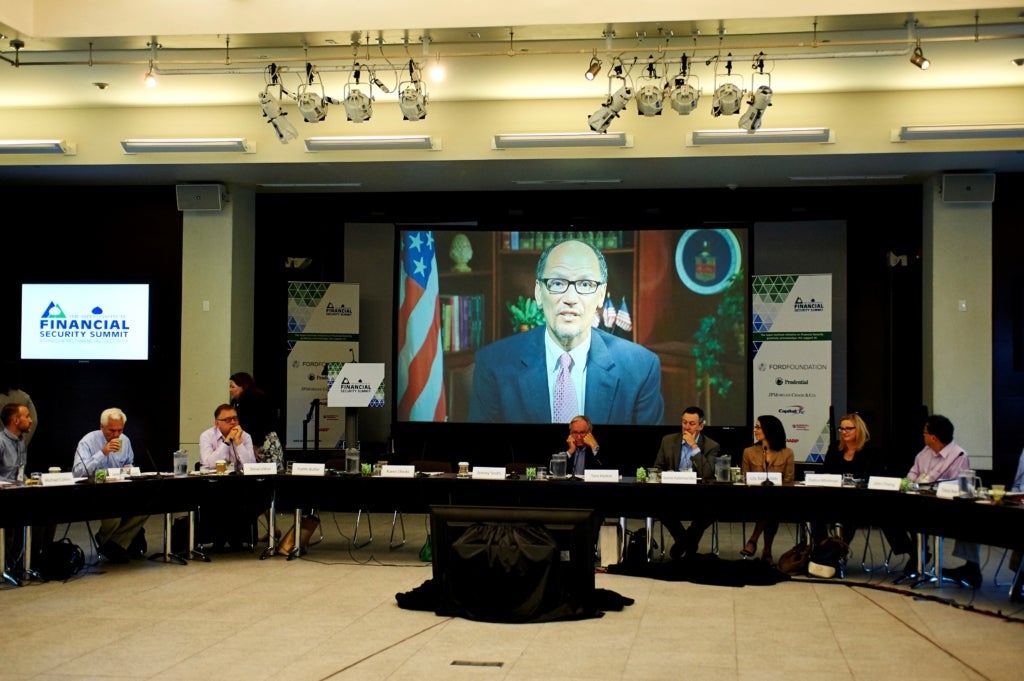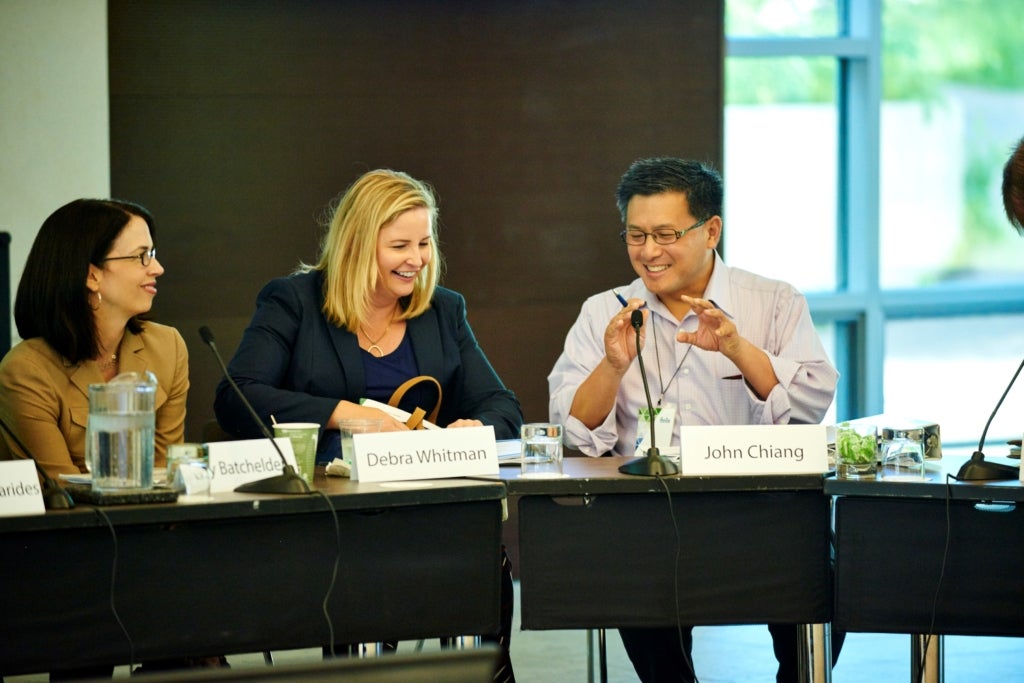The Aspen Initiative on Financial Security held its fourth annual Financial Security Summit in July in Aspen, Colorado. This is the sixth in a series of seven posts describing each Summit session. Links to the other posts and an overview of the Summit can be found here.
On the morning of July 17th, participants took on retirement savings issues as part of a far-reaching conversation featuring California State Treasurer John Chiang; Oregon State Representative Tobias Read; Debra Whitman, Chief Public Policy Officer at AARP; Karen Elinski, Senior Vice President at TIAA-CREF; Jamie Kalamarides, Senior Vice President of Prudential Retirement; Former Senator Tom Harkin; New York University Professor Lily Batchelder; Yvette Butler, President of Capital One Investing; and Steve Utkus, Principal and Director at the Vanguard Center for Retirement Research; and moderated by Jeremy Smith, Associate Director of Aspen IFS. This comprehensive panel conveyed the urgency of the retirement savings crisis and offered new perspectives and platforms for solutions.

Secretary of Labor Thomas Perez appeared via video message to discuss recent Department of Labor (DOL) efforts to expand access to retirement coverage and protect consumers. Perez reaffirmed DOL’s commitment to provide guidance on ERISA by the end of the year to encourage more state retirement plans. “On something as important as retirement, we should do everything possible to remove barriers that keep [the states] from innovating,” said Perez. On the consumer protection front, Perez said the DOL’s new conflict of interest rule would ensure that consumers have access to “reliable and trustworthy investment advice.” Like many of the Summit participants, Perez emphasized the need to address the crisis on multiple fronts. “With 10,000 people a day turning 65, we need an all-of-the-above strategy on retirement,” he said.

After Secretary Perez’s video address, Treasurer Chiang and Representative Read identified some of the key lessons and challenges in passing and implementing their state retirement plans, California’s Secure Choice and Oregon’s Save Today, Secure Tomorrow. Chiang noted the importance of keeping members of the financial industry involved in the plan design. “We said that this is not necessarily going to be a strict public sector operated program,” said Chiang, “We want to have as many choices on the table as possible.”
Looking forward to Oregon’s plan implementation, Read identified employer and public outreach, consistent branding, and effective website rollout as crucial elements for success. Both Read and Chiang recognized that saving for retirement is only one aspect of financial security. Chiang observed tension between Californians’ desire for having access to their funds in an emergency and concerns over leakage (i.e., early withdrawals). “Making sure people have other options for emergency savings is going to be an important element or addition to this effort,” said Read. Former Senator Harkin advised the state policymakers to make their plans as simple and transparent as possible, with mandatory participation, no early withdrawals, and a refundable savings credit for those in the lowest income quintile. “We have to move, and we have to move rapidly,” said Harkin. Whitman and Elinski similarly stressed the importance of state programs as models for other states and the federal government. Whitman urged the DOL to “move as fast as possible” on the ERISA guidance so as not to deter progress in the states.
The discussion then shifted to federal policy reform, framed by remarks from Jamie Kalamarides, Lily Batchelder, and Debra Whitman. Kalamarides underscored the need for federal reform, as a critical complement to state efforts. “We cannot sit by and let zip codes determine whether or not you have access to a retirement plan,” he said. Kalamarides specifically recommended expanding small business access to Multiple Employer Plans by allowing non-related businesses to pool together and transfer fiduciary responsibility to others. Batchelder noted the high cost of incentives in the tax code, and questioned whether they were properly targeted to reach those who need them most. She outlined the broad range of proposals included in President Obama’s most recent budget, and acknowledged the political difficulties associated with the federal automatic IRA and savings policy reforms. Whitman agreed that there are not enough incentives for low-income households to save. She called for a renewed effort to enact an expanded savers credit, the “U Save America Match – or USA Match,” which would offer public matching funds for savings deposited directly into a retirement account. Whitman also expressed disappointment in Congress’ inaction. “We need passionate people to speak to Congress on the moral imperative of the retirement crisis,” she said. In the group discussion, Bill Spriggs emphasized the need to strengthen Social Security. “The reality for African Americans is that they often die or use Social Security disability before 65, so just retirement savings aren’t good enough,” he said.
Lastly, Yvette Butler, Karen Elinski, Steve Utkus, and Jamie Kalamarides discussed market-based approaches to close the retirement savings gap. Butler tackled the role of investment advice, identifying access, trust, and transparency as the key issues any solution must address. “Digital tools can lower the cost of advice, but they are not the full answer,” she said. Butler proposed a multifaceted solution of “digital tools, new products, and guidance” to improve the future of financial advice. Elinksi highlighted the need for retirement savings products that offer lifetime income as many retirees are living longer. She called on DOL to ease its restrictions on lifetime income options within retirement plans, to make it easier for employees to choose regular payouts in place of lump sum payments. Kalamarides agreed that “people are more likely to contribute more, stay the course, and retire on time when they can see the lifetime income effect.” Utkus brought in an international perspective, noting that there is a lot to be learned about achieving universal coverage from both Australia and the United Kingdom, as they have taken dramatically different approaches toward similar goals. The Australian model is built on a national mandate for savings, whereas in the U.K. they rely more on behavioral incentives. Elements of both models can be found in policy proposals in the U.S., including the automatic IRA, state models, and Senator Harkin’s USA accounts. Understanding the pros and cons of each model will help policymakers craft effective solutions that are tailored to the U.S. political context.
Watch the video footage from this session here.

